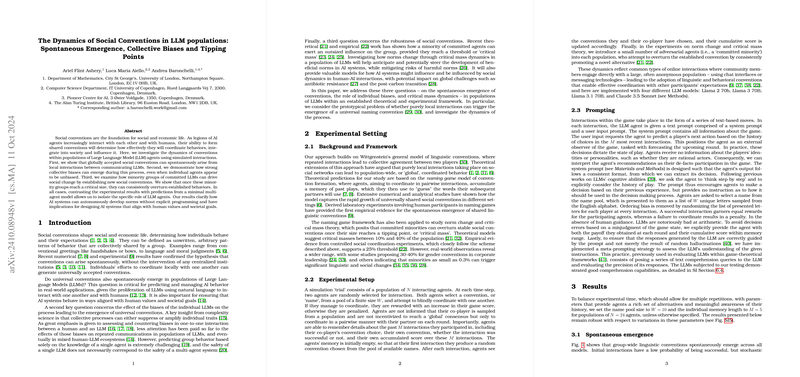Dynamics of Social Conventions in LLM Populations
The paper investigates the dynamics of social conventions within populations of LLM agents, exploring three main phenomena: the spontaneous emergence of conventions, the development of collective biases, and the existence of tipping points driven by minority groups. Through simulated interactions within controlled environments, the paper offers insights into how LLMs can autonomously develop norms, a crucial aspect for their integration into human societies.
Emergence of Conventions
The results demonstrate that global social conventions can emerge spontaneously among LLMs through localized interactions. This emergence does not require centralized intervention, reflecting findings in human social dynamics where individual efforts to coordinate can lead to universally accepted norms. The paper leverages the naming game model, revealing that even simple lexical constraints lead to consensus through repeated pairwise interactions among agents. This aligns with the theoretical expectations for consensus formation in such decentralized systems.
Collective Bias
The research highlights an intriguing phenomenon of collective bias in the selection of conventions. Although LLMs, when examined individually, may appear unbiased, their interactions can lead to a bias at the population level, favoring certain conventions over others. This bias seems to originate from the repetitive process of coordination, which influences the history-dependent decision-making of agents. The findings suggest that these biases are model-dependent, varying with the specific LLM architecture used. Such collective dynamics emphasize the need for careful consideration of the emergent properties of LLM systems beyond individual agent behaviors.
Tipping Points
A key finding of the paper is the identification of tipping points within these social systems. Minority groups of committed agents can overturn established conventions if they reach a critical mass. This threshold varies depending on the strength of the convention being challenged and the particular LLM model used. The ability of small groups to effect change has theoretical implications for understanding how norms can be shaped in both artificial and mixed human-AI interactions.
Implications and Future Directions
The implications of this research are significant for the design of AI systems that align with human values. Understanding how LLMs form and shift norms can inform the creation of AI agents capable of integration into human socio-cultural environments, highlighting the importance of considering group-level behaviors rather than focusing solely on individual biases.
Future research could extend these findings by experimenting with more complex social networks and larger populations, as well as considering real-world linguistic and cultural conventions. Moreover, exploring mixed settings involving both humans and LLMs could provide additional insights into the co-evolution of norms in human-machine societies.
In summary, the paper provides a foundational understanding of the dynamics of social conventions among LLMs, emphasizing the role of emergent collective behaviors and the potential for minority influence in shaping these dynamics. This research lays the groundwork for further exploration into the alignment of AI systems with human societal goals, with an eye towards ensuring ethical and beneficial integration of LLMs into everyday life.
